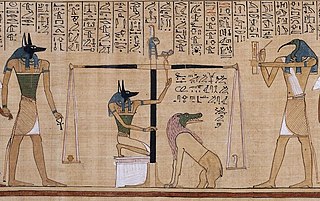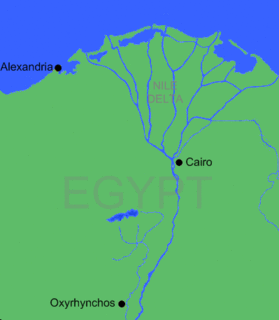
Michel de Nostredame, usually Latinised as Nostradamus, was a French astrologer, physician and reputed seer, who is best known for his book Les Prophéties, a collection of 942 poetic quatrains allegedly predicting future events. The book was first published in 1555.

The Rosetta Stone is a granodiorite stele inscribed with three versions of a decree issued in Memphis, Egypt, in 196 BC during the Ptolemaic dynasty on behalf of King Ptolemy V Epiphanes. The top and middle texts are in Ancient Egyptian using hieroglyphic and Demotic scripts respectively, while the bottom is in Ancient Greek. The decree has only minor differences between the three versions, making the Rosetta Stone key to deciphering the Egyptian scripts.

Egyptian hieroglyphs were the formal writing system used in Ancient Egypt, used for writing the Egyptian language. Hieroglyphs combined logographic, syllabic and alphabetic elements, with a total of some 1,000 distinct characters. Cursive hieroglyphs were used for religious literature on papyrus and wood. The later hieratic and demotic Egyptian scripts were derived from hieroglyphic writing, as was the Proto-Sinaitic script that later evolved into the Phoenician alphabet. Through the Phoenician alphabet's major child systems, the Egyptian hieroglyphic script is ancestral to the majority of scripts in modern use, most prominently the Latin and Cyrillic scripts and the Arabic script and possibly Brahmic family of scripts.

Jean-François Champollion, also known as Champollion le jeune, was a French scholar, philologist and orientalist, known primarily as the decipherer of Egyptian hieroglyphs and a founding figure in the field of Egyptology. Partially raised by his brother, the noted scholar Jacques Joseph Champollion-Figeac, Champollion was a child prodigy in philology, giving his first public paper on the decipherment of Demotic in his mid teens. As a young man he was renowned in scientific circles, and spoke Coptic, Ancient Greek, Latin, Hebrew and Arabic.

Athanasius Kircher was a German Jesuit scholar and polymath who published around 40 major works, most notably in the fields of comparative religion, geology, and medicine. Kircher has been compared to fellow Jesuit Roger Joseph Boscovich and to Leonardo da Vinci for his enormous range of interests, and has been honoured with the title "Master of a Hundred Arts". He taught for more than 40 years at the Roman College, where he set up a wunderkammer. A resurgence of interest in Kircher has occurred within the scholarly community in recent decades.

The Book of the Dead is an ancient Egyptian funerary text generally written on papyrus and used from the beginning of the New Kingdom to around 50 BCE. The original Egyptian name for the text, transliterated rw nw prt m hrw, is translated as Book of Coming Forth by Day or Book of Emerging Forth into the Light. "Book" is the closest term to describe the loose collection of texts consisting of a number of magic spells intended to assist a dead person's journey through the Duat, or underworld, and into the afterlife and written by many priests over a period of about 1,000 years.

Tanis is the Greek name for ancient Egyptian ḏꜥn.t, an important archaeological site in the north-eastern Nile Delta of Egypt, and the location of a city of the same name. It is located on the Tanitic branch of the Nile, which has long since silted up. The first study of Tanis dates to 1798 during Napoléon Bonaparte's expedition to Egypt. Engineer Pierre Jacotin drew up a map of the site in the Description de l'Égypte. It was first excavated in 1825 by Jean-Jacques Rifaud, who discovered the two pink granite sphinxes now in the Musée du Louvre, and then by François Auguste Ferdinand Mariette between 1860 and 1864, and subsequently by William Matthew Flinders Petrie from 1883 to 1886. The work was taken over by Pierre Montet from 1929 to 1956, who discovered the royal necropolis dating to the Third Intermediate Period in 1939. The Mission française des fouilles de Tanis (MFFT) has been studying the site since 1965 under the direction of Jean Yoyotte and Philippe Brissaud, and François Leclère since 2013.

Pedanius Dioscorides was a Greek physician, pharmacologist, botanist, and author of De materia medica —a 5-volume Greek encyclopedia about herbal medicine and related medicinal substances, that was widely read for more than 1,500 years. He was employed as a physician in the Roman army.

Materia medica is a Latin term from the history of pharmacy for the body of collected knowledge about the therapeutic properties of any substance used for healing. The term derives from the title of a work by the Ancient Greek physician Pedanius Dioscorides in the 1st century AD, De materia medica, 'On medical material'.

Oedipus Aegyptiacus is Athanasius Kircher's supreme work of Egyptology.

Pierre Belon (1517–1564) was a French traveler, naturalist, writer and diplomat. Like many others of the Renaissance period, he studied and wrote on a range of topics including ichthyology, ornithology, botany, comparative anatomy, architecture and Egyptology. He is sometimes known as Pierre Belon du Mans, or, in the Latin in which his works appeared, as Petrus Bellonius Cenomanus. Ivan Pavlov called him the "prophet of comparative anatomy".

Lucius Junius Moderatus Columella was a prominent writer on agriculture in the Roman empire.
Horapollo is the supposed author of a treatise, titled Hieroglyphica, on Egyptian hieroglyphs, extant in a Greek translation by one Philippus, dating to about the 5th century.

Oxyrhynchus is a city in Middle Egypt located about 160 km south-southwest of Cairo in Minya Governorate. It is also an archaeological site, considered one of the most important ever discovered. Since the late 19th century, the area around Oxyrhynchus has been excavated almost continually, yielding an enormous collection of papyrus texts dating from the Ptolemaic Kingdom and Roman Egypt. Among the texts discovered at Oxyrhynchus are plays of Menander, fragments from the Gospel of Thomas, and fragments from Euclid's Elements. They also include a few vellum manuscripts, and more recent Arabic manuscripts on paper.

The Aethiopica or Theagenes and Chariclea is an ancient Greek novel which has been dated to the 220s or 370s AD. It was written by Heliodorus of Emesa and is his only known work.

The writing systems used in ancient Egypt were deciphered in the early nineteenth century through the work of several European scholars, especially Jean-François Champollion and Thomas Young. Ancient Egyptian forms of writing, which included the hieroglyphic, hieratic and demotic scripts, ceased to be understood in the fourth and fifth centuries AD, as the Coptic alphabet was increasingly used in their place. Later generations' knowledge of the older scripts was based on the work of Greek and Roman authors whose understanding was faulty. It was thus widely believed that Egyptian scripts were exclusively ideographic, representing ideas rather than sounds, and even that hieroglyphs were an esoteric, mystical script rather than a means of recording a spoken language. Some attempts at decipherment by Islamic and European scholars in the Middle Ages and early modern times acknowledged the script might have a phonetic component, but perception of hieroglyphs as purely ideographic hampered efforts to understand them as late as the eighteenth century.
Francesco Salvolini was a scholar of Ancient Egyptian hieroglyphs who worked with Jean-François Champollion on deciphering hieroglyphs near the end of the latter's life. He is known to have been in possession of some of Champollion's manuscripts and to have used them as a basis for his own subsequent publications on the subject, claiming the work as his own.

Events from the year 1555 in France.

The Caylus vase is a jar in alabaster dedicated in the name of the Achaemenid king Xerxes I in Egyptian hieroglyph and Old Persian cuneiform. It was the key element in confirming the decipherment of Old Persian cuneiform by Grotefend, through the reading of the hieroglyphic part by Champollion in 1823. It also confirmed the antiquity of phonetical hieroglyphs before the time of Alexander the Great, thus corroborating the phonetical decipherment of the names of ancient Egyptian pharaohs. The vase was named after Anne Claude de Tubières, count of Caylus, an early French collector, who had acquired the vase in the 18th century, between 1752 and 1765. It is now located in the Cabinet des Médailles, Paris.

Champollion: A Scribe for Egypt is a 2000 documentary film adapted from French Egyptologist Michel Dewachter's nonfiction book of the same name. Directed by Jean-Claude Lubtchansky, and co-produced by Trans Europe Film, La Sept-Arte, Éditions Gallimard and Louvre Museum, with voice-over narration by French actors Françoise Fabian and Jean-Hugues Anglade, the film retraces step by step the passionate journey which led Jean-François Champollion to decipher Egyptian hieroglyphs.

















